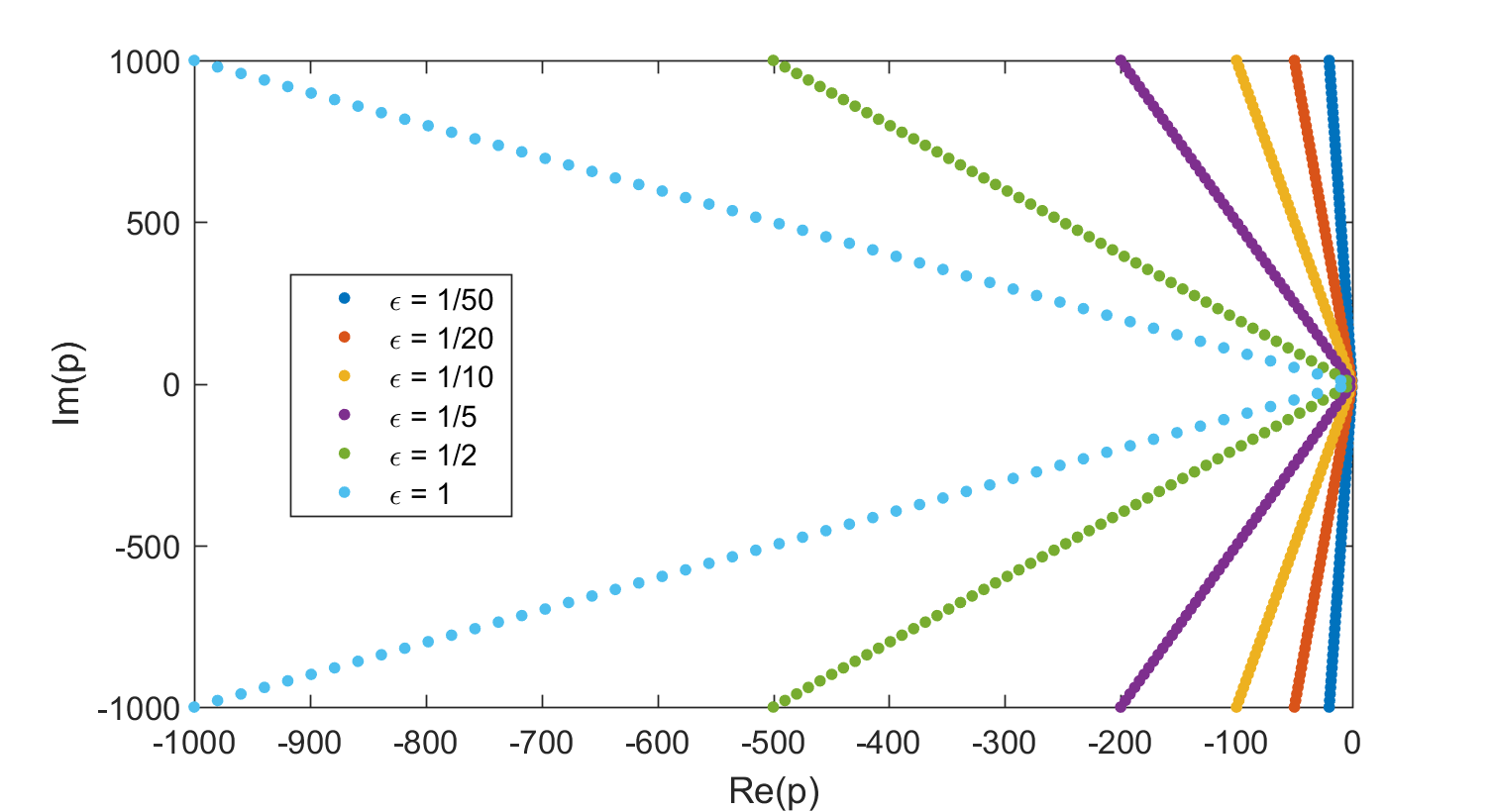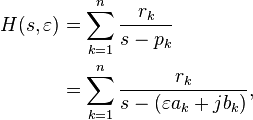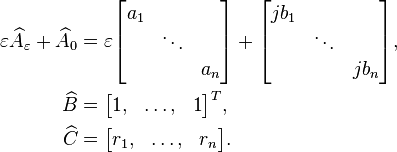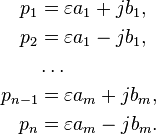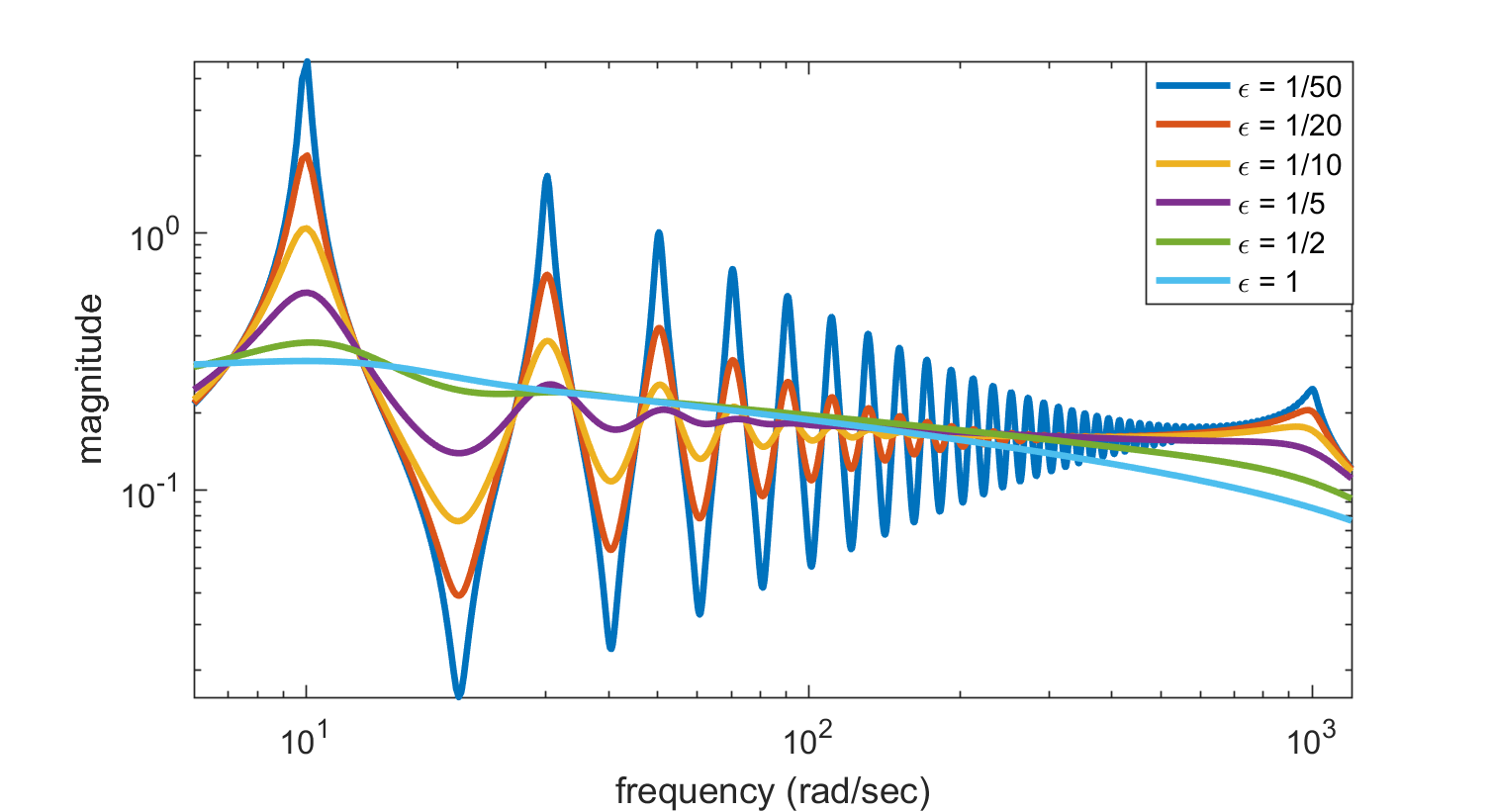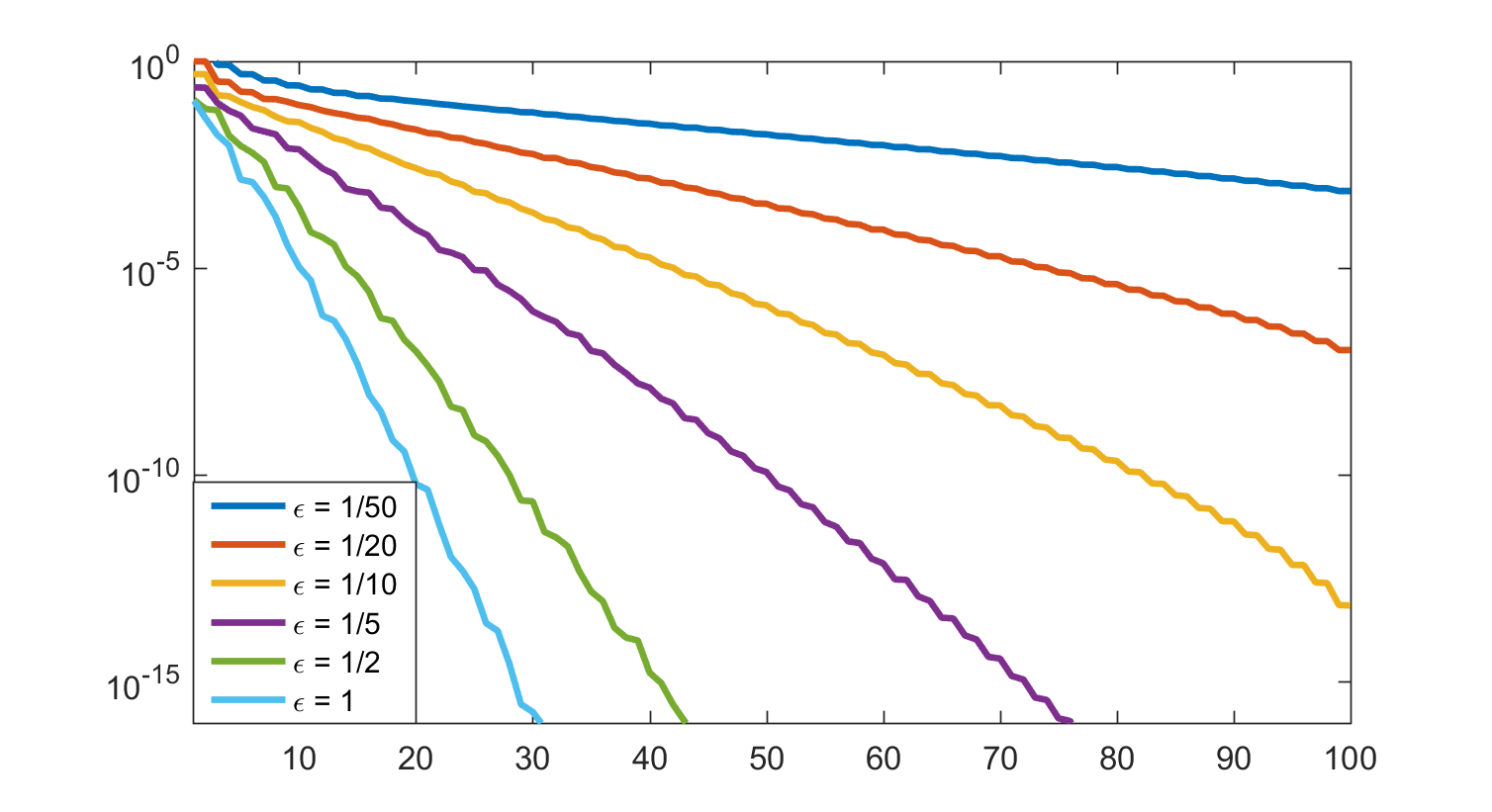m |
(Rewritten first sections, added planned sections.) |
||
| Line 8: | Line 8: | ||
[[Category:Sparse]] |
[[Category:Sparse]] |
||
| − | == |
+ | ==Description== |
| ⚫ | |||
| ⚫ | |||
| ⚫ | |||
| − | Also, the decay of the Hankel singular values can be changed indirectly through the parameter |
+ | Also, the decay of the Hankel singular values can be changed indirectly through the parameter. |
| − | == |
+ | ===Model=== |
| + | We consider a dynamical system in the frequency domain given by its pole-residue form of the transfer function |
||
| − | The parameter <math>\varepsilon</math> scales the real part of the system poles, that is, <math>p_i=\varepsilon a_i+jb_i \, </math>, with <math> j </math> the imaginary unit. |
||
| − | For a system in pole-residue form |
||
| + | :<math> |
||
| + | \begin{align} |
||
| + | H(s,\varepsilon) & = \sum_{k=1}^{n}\frac{r_{k}}{s-p_{k}}\\ |
||
| + | & = \sum_{k=1}^{n}\frac{r_{k}}{s-(\varepsilon a_{k} + jb_{k})}, |
||
| + | \end{align} |
||
| + | </math> |
||
| + | with <math>p_{k} = \varepsilon a_{k} + jb_{k}</math> the poles of the system, <math>j</math> the imaginary unit, and <math>r_{k}</math> the residues. |
||
| − | :<math> H(s,\varepsilon) = \sum_{i=1}^{n}\frac{r_i}{s-p_i} = \sum_{i=1}^{n}\frac{r_i}{s-(\varepsilon a_i+jb_i)} </math> |
||
| + | The parameter <math>\varepsilon</math> is used to scale the real part of the system poles. |
||
| ⚫ | |||
| + | :<math> |
||
| + | \begin{align} |
||
| + | H(s,\varepsilon) = \widehat{C}(sI_{n} - (\varepsilon \widehat{A}_{\varepsilon} + \widehat{A}_{0}))^{-1}\widehat{B}, |
||
| + | \end{align} |
||
| + | </math> |
||
| + | with the corresponding system matrices <math>\widehat{A}_{\varepsilon} \in \mathbb{R}^{n \times n}</math>, <math>\widehat{A}_{0} \in \mathbb{C}^{n \times n}</math>, <math>\widehat{B} \in \mathbb{R}^{n}</math>, and <math>\widehat{C}^{T} \in \mathbb{C}^{n}</math> given by |
||
| ⚫ | |||
| + | :<math> |
||
| + | \begin{align} |
||
| + | \varepsilon\widehat{A}_{\varepsilon} + \widehat{A}_{0} |
||
| + | & = \varepsilon \begin{bmatrix} a_{1} & & \\ & \ddots & \\ & & a_{n} \end{bmatrix} |
||
| + | + \begin{bmatrix} jb_{1} & & \\ & \ddots & \\ & & jb_{n} \end{bmatrix},\\ |
||
| + | \widehat{B} & = \begin{bmatrix}1, & \ldots, & 1 \end{bmatrix}^{T},\\ |
||
| + | \widehat{C} & = \begin{bmatrix}r_{1}, & \ldots, & r_{n} \end{bmatrix}. |
||
| + | \end{align} |
||
| + | </math> |
||
| − | + | One notices that the system matrices <math>\widehat{A}_{0}</math> and <math>\widehat{C}</math> have complex entries. |
|
| ⚫ | |||
| + | :<math> |
||
| + | \begin{align} |
||
| + | p_{1} & = \varepsilon a_{1} + jb_{1},\\ |
||
| + | p_{2} & = \varepsilon a_{1} - jb_{1},\\ |
||
| + | & \ldots\\ |
||
| + | p_{n-1} & = \varepsilon a_{m} + jb_{m},\\ |
||
| + | p_{n} & = \varepsilon a_{m} - jb_{m}. |
||
| + | \end{align} |
||
| + | </math> |
||
| + | Corresponding to the system poles, also the residues are written in complex conjugate pairs |
||
| − | with system matrices defined as |
||
| + | :<math> |
||
| + | \begin{align} |
||
| + | r_{1} & = c_{1} + jd_{1},\\ |
||
| + | r_{2} & = c_{1} - jd_{1},\\ |
||
| + | & \ldots\\ |
||
| + | r_{n-1} & = c_{m} + jd_{m},\\ |
||
| + | r_n & = c_{m} - jd_{m}. |
||
| + | \end{align} |
||
| + | </math> |
||
| ⚫ | |||
| − | :<math>\varepsilon \widehat{A}_\varepsilon + \widehat{A}_0 = \varepsilon \left[\begin{array}{ccc} a_1 & & \\ & \ddots & \\ & & a_n\end{array}\right] +\left[\begin{array}{ccc} jb_1 & & \\ & \ddots & \\ & & jb_n\end{array}\right] ,</math> |
||
| + | :<math> |
||
| − | :<math>\widehat{B} = [1,\ldots,1]^T,\quad \widehat{C} = [r_1,\ldots,r_n],\quad D = 0.</math> |
||
| + | \begin{align} |
||
| + | A_{\varepsilon} & = \begin{bmatrix} A_{\varepsilon, 1} & & \\ & \ddots & \\ & & A_{\varepsilon, m} \end{bmatrix}, & |
||
| + | A_{0} & = \begin{bmatrix} A_{0, 1} & & \\ & \ddots & \\ & & A_{0, m} \end{bmatrix}, & |
||
| + | B & = \begin{bmatrix} B_{1} \\ \vdots \\ B_{m} \end{bmatrix}, & |
||
| + | C & = \begin{bmatrix} C_{1}, & \cdots, & C_{m} \end{bmatrix}, |
||
| + | \end{align} |
||
| + | </math> |
||
| + | with <math>A_{\varepsilon, k} = \begin{bmatrix} a_{k} & 0 \\ 0 & a_{k} \end{bmatrix}</math>, <math>A_{0, k} = \begin{bmatrix} 0 & b_{k} \\ -b_{k} & 0 \end{bmatrix}</math>, <math>B_{k} = \begin{bmatrix} 2 \\ 0 \end{bmatrix}</math>, <math>C_{k} = \begin{bmatrix} c_k, & d_k \end{bmatrix}</math>. |
||
| ⚫ | |||
| − | |||
| − | Notice that the system matrices have complex entries. |
||
| − | |||
| ⚫ | |||
| − | |||
| − | :<math> p_1 = \varepsilon a_1+jb_1, p_2 = \varepsilon a_1-jb_1, \ldots, p_{n-1} = \varepsilon a_k+jb_k, p_n = \varepsilon a_k-jb_k, </math> |
||
| − | |||
| − | and the residues also form complex conjugate pairs |
||
| − | |||
| − | :<math> r_1 = c_1+jd_1, r_2 = c_1-jd_1, \ldots, r_{n-1} = c_k+jd_k, r_n = c_k-jd_k. </math> |
||
| − | |||
| ⚫ | |||
| − | |||
| − | |||
| − | :<math> A_\varepsilon = \left[\begin{array}{ccc} A_{\varepsilon,1} & & \\ & \ddots & \\ & & A_{\varepsilon,k}\end{array}\right], \quad A_0 = \left[\begin{array}{ccc} A_{0,1} & & \\ & \ddots & \\ & & A_{0,k}\end{array}\right], \quad B = \left[\begin{array}{c} B_1 \\ \vdots \\ B_k\end{array}\right], \quad C = \left[\begin{array}{ccc} C_1 & \cdots & C_k\end{array}\right], \quad D = 0,</math> |
||
| − | |||
| − | |||
| − | with <math> A_{\varepsilon,i} = \left[\begin{array}{cc} a_i& 0 \\ 0 & a_i \end{array}\right] </math>, |
||
| − | <math> A_{0,i} = \left[\begin{array}{cc} 0& b_i \\ -b_i & 0 \end{array}\right] </math>, |
||
| − | <math> B_{i} = \left[\begin{array}{c} 2 \\ 0 \end{array}\right] </math>, |
||
| − | <math> C_{i} = \left[\begin{array}{cc} c_i& d_i\end{array}\right] </math>. |
||
| − | |||
| ⚫ | |||
We construct a system of order <math>n = 100</math>. The numerical values for the different variables are |
We construct a system of order <math>n = 100</math>. The numerical values for the different variables are |
||
| Line 97: | Line 124: | ||
:[[Image:synth_freq_resp.png|frame|border|left|Frequency response of synthetic parametric system, for parameter values 1/50 (blue), 1/20 (green), 1/10 (red), 1/5 (teal), 1/2 (purple), 1 (yellow).]] |
:[[Image:synth_freq_resp.png|frame|border|left|Frequency response of synthetic parametric system, for parameter values 1/50 (blue), 1/20 (green), 1/10 (red), 1/5 (teal), 1/2 (purple), 1 (yellow).]] |
||
| ⚫ | |||
| Line 128: | Line 154: | ||
[[Image:synth_hsv.png|frame|border|center|Hankel singular values of synthetic parametric system, for parameter values 1/50 (blue), 1/20 (green), 1/10 (red), 1/5 (teal), 1/2 (purple), 1 (yellow).]] |
[[Image:synth_hsv.png|frame|border|center|Hankel singular values of synthetic parametric system, for parameter values 1/50 (blue), 1/20 (green), 1/10 (red), 1/5 (teal), 1/2 (purple), 1 (yellow).]] |
||
| + | ==Data== |
||
| + | |||
| + | ==Dimensions== |
||
| + | ==Citation== |
||
==Contact== |
==Contact== |
||
Revision as of 21:38, 5 April 2018
Description
On this page you will find a synthetic parametric model with one parameter for which one can easily experiment with different system orders, values of the parameter, as well as different poles and residues. Also, the decay of the Hankel singular values can be changed indirectly through the parameter.
Model
We consider a dynamical system in the frequency domain given by its pole-residue form of the transfer function
with  the poles of the system,
the poles of the system,  the imaginary unit, and
the imaginary unit, and  the residues.
The parameter
the residues.
The parameter  is used to scale the real part of the system poles.
We can write down the state-space realization of the system's transfer function as
is used to scale the real part of the system poles.
We can write down the state-space realization of the system's transfer function as
with the corresponding system matrices  ,
,  ,
,  , and
, and  given by
given by
One notices that the system matrices  and
and  have complex entries.
For rewriting the system with real matrices, we assume that
have complex entries.
For rewriting the system with real matrices, we assume that  is even,
is even,  , and that all system poles are complex and ordered in complex conjugate pairs, i.e.,
, and that all system poles are complex and ordered in complex conjugate pairs, i.e.,
Corresponding to the system poles, also the residues are written in complex conjugate pairs
Using this, the realization of the dynamical system can be written with matrices having real entries by
with  ,
,  ,
,  ,
,  .
.
Numerical Values
We construct a system of order  . The numerical values for the different variables are
. The numerical values for the different variables are
 equally spaced in
equally spaced in ![[-10^3, -10]](/morwiki/images/math/0/1/e/01eb0216a83386dce806710ccd49014d.png) ,
,
 equally spaced in
equally spaced in ![[10, 10^3]](/morwiki/images/math/0/b/e/0be1e9dea133f5e55f228e67a2ea56b4.png) ,
,
 ,
,
 ,
,

![\in [1/50,1]](/morwiki/images/math/3/4/0/3409a13a32f034288c27700bb927d09e.png) .
.
In MATLAB, the system matrices are easily formed as follows:
n = 100;
a = -linspace(1e1,1e3,n/2).'; b = linspace(1e1,1e3,n/2).';
c = ones(n/2,1); d = zeros(n/2,1);
aa(1:2:n-1,1) = a; aa(2:2:n,1) = a;
bb(1:2:n-1,1) = b; bb(2:2:n-2,1) = 0;
Ae = spdiags(aa,0,n,n);
A0 = spdiags([0;bb],1,n,n) + spdiags(-bb,-1,n,n);
B = 2*sparse(mod([1:n],2)).';
C(1:2:n-1) = c.'; C(2:2:n) = d.'; C = sparse(C);
The above system matrices  are also available in MatrixMarket format Synth_matrices.tar.gz.
are also available in MatrixMarket format Synth_matrices.tar.gz.
Plots
We plot the frequency response  and poles for parameter values
and poles for parameter values ![\varepsilon \in [1/50, 1/20, 1/10, 1/5, 1/2, 1]](/morwiki/images/math/1/f/7/1f7392c05a89973f3622df1b8cd09a32.png) .
.
In MATLAB, the plots are generated using the following commands:
r(1:2:n-1,1) = c+1j*d; r(2:2:n,1) = c-1j*d;
ep = [1/50; 1/20; 1/10; 1/5; 1/2; 1]; % parameter epsilon
jw = 1j*linspace(0,1.2e3,5000).'; % frequency grid
for j = 1:length(ep)
p(:,j) = [ep(j)*a+1j*b; ep(j)*a-1j*b]; % poles
[jww,pp] = meshgrid(jw,p(:,j));
Hjw(j,:) = (r.')*(1./(jww-pp)); % freq. resp.
end
figure, loglog(imag(jw),abs(Hjw),'LineWidth',2)
axis tight, xlim([6 1200])
xlabel('frequency (rad/sec)')
ylabel('magnitude')
title('Frequency response for different \epsilon')
figure, plot(real(p),imag(p),'.')
title('Poles for different \epsilon')
Other interesting plots result for small values of the parameter. For example, for  , the peaks in the frequency response become more pronounced, since the poles move closer to the imaginary axis.
, the peaks in the frequency response become more pronounced, since the poles move closer to the imaginary axis.
Next, for ![\varepsilon \in [1/50, 1/20, 1/10, 1/5, 1/2, 1]](/morwiki/images/math/1/f/7/1f7392c05a89973f3622df1b8cd09a32.png) , we also plot the decay of the Hankel singular values. Notice that for small values of the parameter, the decay of the Hankel singular values is very slow.
, we also plot the decay of the Hankel singular values. Notice that for small values of the parameter, the decay of the Hankel singular values is very slow.

